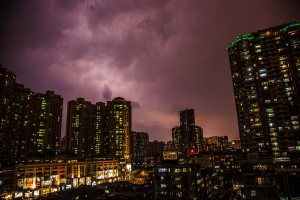
The day has 24 hours, and if you believe daylight is necessary for shooting nature, street and city images, you are missing out on a lot. The night is full of rich and vivid colours, and motives that may seem dull and uninteresting at day can be beautiful and exciting during night.
You can compensate for the lack of light by using long exposure or by using more light sensitive equipment, or of course a combination of both. If you have a camera with image stabilization and very good ISO performance, a lens with aperture 2.8 or larger, you can often manage to shoot on free hand.
I sometimes get decent results with my Canon 5D Mark II set to ISO 6400. But I find high ISO settings much more useful in other situations. I like my night images crystal clear and sharp, without disturbing noise, and a longer exposure is a cheap tribute to pay, if you can accept light trails from cars, moving people appear blurry, water appearing soft and still and similar.
In fact, most people love the effects achieved by long exposure.
When to shoot by freehand and when to use a tripod depends on:
- Your cameras ISO performance
- What focal length you use. (Longer focal length demands shorter exposures on freehand).
- How light sensitive your lens is.
- Your cameras built in noise reduction. (Watch out with that. If your camera already reduced the noise, when editing the images you may find it difficult to reduce more without loosing to much detail).
- If you need to freeze moving objects or not.
- How long you want your focal point to be.
Let me explain through a few examples.
Night snapshots

Snapshot situations often demand short exposure times, especially if the motive is people. On the other hand you can often accept a short focus depth and some noise.
You see something and you want to capture the moment, typically in an urban environment. For this situation you need a camera with good ISO performance. Many newer camera models have excellent ISO performance at reasonable prises. A wide-angle lens with fixed focus, perhaps a 28, 35 or 40 with aperture 2.0 or larger are perfect for most situations.
I often use a small Leica D-LUX 5. It has excellent ISO-performance, and it seems it treats bad light stations excellent. There is a difference not only depending on the components in the camera, but also on the software it uses. After all, today’s cameras are computers with lenses on.
Snapshot situations often demand short exposure times, especially if the motive is people. On the other hand you can often accept a short focus depth and some noise.
For this kind of photography it is not necessary to own a tripod. The world is full of objects that will serve as support for you camera, especially in the city. Use your imagination. But if you for instance should bring a mini tripod you’ll find it very useful.

The night is full of rich and vivid colors, and motives that may seem dull and uninteresting at day can be beautiful and exciting during night.
Taking nature images at night
Sometimes nature is at its best at night. Start with the magic hour, the time when the sun is down, but when the sky is not yet entirely black. It will be dark blue and you’ll be able to use shorter exposures. Look especially for part cloudy and windless night. Otherwise the trees may appear blurry and the clouds without contours.
I usually prefer exposures of between 10 to 40 seconds. More than that and the earth rotations make the stars appear as lines in the sky. If that’s an effect you are looking for, you probably want exposures of at least a few minutes.
Painting with light
A good image usually contains a foreground, a motive and a background. Lets assume that the foreground is flowers or leafs from a tree, the motive a tree or a person and the background are fields or water and sky.

The flash have the advantage that it can freeze a moving object, that otherwise would become blurry.
Then the motive is often a challenge. It usually becomes a black contour against the lighter background.
One way of handling this is by painting with light. You can use a flash or a lamp to do this. Simply put the camera on a tripod and walk around and enlighten the motive an/or the foreground.
The flash have the advantage that it can freeze a moving object, that otherwise would become blurry. For that reason you’ll most likely need a flash when shooting night images with people in. No matter how much you try it’s almost impossible to stand exactly still for as much as 30 seconds. The slightest move and you’ll come out blurry. The same goes for trees. The slightest wind and the sharpness are gone. But don’t forget to reduce the strength of the flash, to make lighting look more natural.
Use manual settings
Normally the camera’s automatic functions don’t work very well during night. Remember that you may also need to shoot with higher aperture in order to get the full image sharp, from foreground to background. Use trial and error. Take a picture, check it and make adjustments. Then try again.
One step on the aperture is normally equal to doubling or half the exposure time and vice versa. One step on your ISO setting is too.
You can of course also use the largest aperture (1,4, 2, 2,8) to make the background appear blurry if you want to highlight the motive.
I recommend raw editing for almost everything and night images are no exception. Editing in raw can be very useful for removing unwanted colours from tungsten lamps or similar artificial light sources. It is also god for using noise reduction, increasing the light in white to make stars appear brighter or decreasing white to make lamps less bright. Dark shadows can come to life very nicely if you increase the light in the shadows. Read my post on raw editing and you’ll know what I mean.
So get your gear and explore the night. You’ll have great fun.


